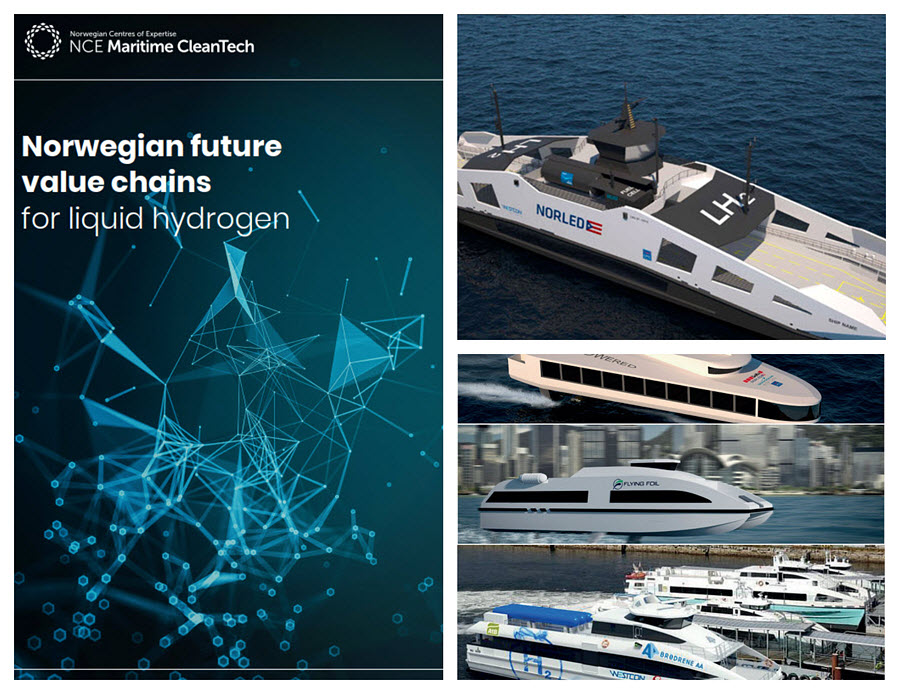
NCE Maritime CleanTech and Greensight have launched a new report that estimates the future maritime hydrogen demand in Western Norway. The report also outlines the largest barriers for implementation of hydrogen in large scale.
On the background of the Paris agreement and IMO’s target for 50 % reduction in CO2 emissions from shipping, there is an increasing need for zero-emission solutions for all vessel segments. International shipping now points to hydrogen as one of the most realistic zero-emission fuels for larger ships and longer distances.

In the report the future regional demand for LH2 in Norway is estimated. The two most southern counties, Rogaland and Hordaland, represent most of the demand with over 60 percent of the total.
“Several ongoing activities point to liquid hydrogen as part of the solution for ships with larger energy needs. The technology development is well under way, but we lack a supply chain for LH2 for maritime use. This reports aims to assist the development of a complete value chain by highlighting the barriers for implementation and estimating the potential future need for hydrogen in the Western part of Norway, says NCE Maritime CleanTech CEO Hege Økland.
The research and analysis for the report have been executed by Greensight and Norled, with support from Equinor and Gasnor. The mapping has been partly financed by Hordaland County Council.
– The Norwegian Counties are obliged to contribute to the achievement of national and international emission targets. Hordaland has a large shipping activity and many harbours, and we see maritime transport, shipping and aquaculture as keys to accelerate the demand for hydrogen within transport, says Mette Nora Sætre, Head of regional economic development at Hordaland County Council.
A potential demand of 105 000 tons LH2 per year
The new report has studied how a major transformation of fuel supply within the segments of car ferries, high-speed crafts and platform supply vessels would affect the need for LH2 in Western Norway. In the analysis two ferry routes and 26 high-speed craft routes have been found likely to run on hydrogen. The total demand, if all these vessels convert to LH2, is about 105 000 tons LH2 per year and 287 tons LH2 per day. This represents over 80 percent of today’s global production capacity.
– The most important factor for the dimension of a future value chain for liquid hydrogen is the expected market demand. Our report shows that just a few passenger routes or PSVs switching fuels would represent a substantial increase in demand for LH2. Criteria for emission reductions in public tenders can therefore be an effective tool to increase the demand, says Martin Larsen Hirth, Energy Analyst at Greensight.
The report also estimate that in 2030 liquid hydrogen can compete with current bio-diesel prices and ammonia in terms of fuel cost alone.
Need for local production
The NCE Maritime CleanTech and Greensight report has further identified several barriers that need increased intention in the years to come.
– A first step for creating a Norwegian value chain is to create a demand that leads to production of liquid hydrogen in Norway. Our volume scenarios and cost comparisons clearly show that the current European capacity is both too small and distant to serve a Norwegian maritime market, says Økland.
Another barrier identified is cost development within production and infrastructure. For production of hydrogen from natural gas, which currently is cheaper than electrolysis, the report also finds that carbon capture and storage (CCS) is necessary in order to achieve a low enough level of kgCO2/kg LH2 to label hydrogen from natural gas as blue hydrogen.
A large-scale implementation of hydrogen in shipping is further dependent on new technology development, especially within new cost efficient or flexible forms of distribution for larger volumes. There is also a need for the development of international standards for a maritime use of hydrogen, especially concerning bunkering.
NCE Maritime CleanTech and its partners will follow up the findings within the cluster’s expert group for hydrogen, that works to facilitate a supply chain for liquid hydrogen and related fuels.
Read the report in full here
Read the most up to date Fuel Cell and Hydrogen Industry news at FuelCellsWorks




